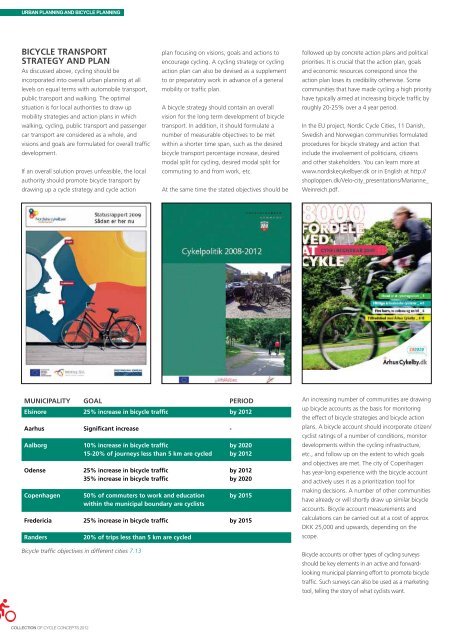Collection of Cycle Concepts 2012.pdf - Fietsberaad
Collection of Cycle Concepts 2012.pdf - Fietsberaad
Collection of Cycle Concepts 2012.pdf - Fietsberaad
Create successful ePaper yourself
Turn your PDF publications into a flip-book with our unique Google optimized e-Paper software.
URBAN PLANNING AND BICYCLE PLANNING<br />
BICYCLE TRANSPORT<br />
STRATEGY AND PLAN<br />
As discussed above, cycling should be<br />
incorporated into overall urban planning at all<br />
levels on equal terms with automobile transport,<br />
public transport and walking. The optimal<br />
situation is for local authorities to draw up<br />
mobility strategies and action plans in which<br />
walking, cycling, public transport and passenger<br />
car transport are considered as a whole, and<br />
visions and goals are formulated for overall traffic<br />
development.<br />
If an overall solution proves unfeasible, the local<br />
authority should promote bicycle transport by<br />
drawing up a cycle strategy and cycle action<br />
plan focusing on visions, goals and actions to<br />
encourage cycling. A cycling strategy or cycling<br />
action plan can also be devised as a supplement<br />
to or preparatory work in advance <strong>of</strong> a general<br />
mobility or traffic plan.<br />
A bicycle strategy should contain an overall<br />
vision for the long term development <strong>of</strong> bicycle<br />
transport. In addition, it should formulate a<br />
number <strong>of</strong> measurable objectives to be met<br />
within a shorter time span, such as the desired<br />
bicycle transport percentage increase, desired<br />
modal split for cycling, desired modal split for<br />
commuting to and from work, etc.<br />
At the same time the stated objectives should be<br />
followed up by concrete action plans and political<br />
priorities. It is crucial that the action plan, goals<br />
and economic resources correspond since the<br />
action plan loses its credibility otherwise. Some<br />
communities that have made cycling a high priority<br />
have typically aimed at increasing bicycle traffic by<br />
roughly 20-25% over a 4 year period.<br />
In the EU project, Nordic <strong>Cycle</strong> Cities, 11 Danish,<br />
Swedish and Norwegian communities formulated<br />
procedures for bicycle strategy and action that<br />
include the involvement <strong>of</strong> politicians, citizens<br />
and other stakeholders. You can learn more at<br />
www.nordiskecykelbyer.dk or in English at http://<br />
shoploppen.dk/Velo-city_presentations/Marianne_<br />
Weinreich.pdf.<br />
Municipality Goal Period<br />
Elsinore 25% increase in bicycle traffic by 2012<br />
Aarhus Significant increase -<br />
Aalborg 10% increase in bicycle traffic by 2020<br />
15-20% <strong>of</strong> journeys less than 5 km are cycled by 2012<br />
Odense 25% increase in bicycle traffic by 2012<br />
35% increase in bicycle traffic by 2020<br />
Copenhagen 50% <strong>of</strong> commuters to work and education by 2015<br />
within the municipal boundary are cyclists<br />
Fredericia 25% increase in bicycle traffic by 2015<br />
Randers<br />
20% <strong>of</strong> trips less than 5 km are cycled<br />
Bicycle traffic objectives in different cities 7.13<br />
An increasing number <strong>of</strong> communities are drawing<br />
up bicycle accounts as the basis for monitoring<br />
the effect <strong>of</strong> bicycle strategies and bicycle action<br />
plans. A bicycle account should incorporate citizen/<br />
cyclist ratings <strong>of</strong> a number <strong>of</strong> conditions, monitor<br />
developments within the cycling infrastructure,<br />
etc., and follow up on the extent to which goals<br />
and objectives are met. The city <strong>of</strong> Copenhagen<br />
has year-long experience with the bicycle account<br />
and actively uses it as a prioritization tool for<br />
making decisions. A number <strong>of</strong> other communities<br />
have already or will shortly draw up similar bicycle<br />
accounts. Bicycle account measurements and<br />
calculations can be carried out at a cost <strong>of</strong> approx.<br />
DKK 25,000 and upwards, depending on the<br />
scope.<br />
Bicycle accounts or other types <strong>of</strong> cycling surveys<br />
should be key elements in an active and forwardlooking<br />
municipal planning effort to promote bicycle<br />
traffic. Such surveys can also be used as a marketing<br />
tool, telling the story <strong>of</strong> what cyclists want.



